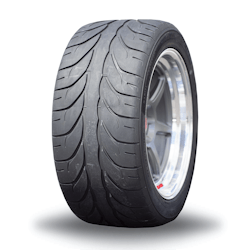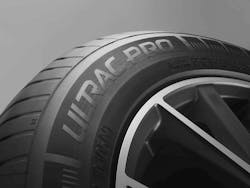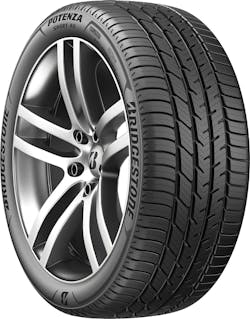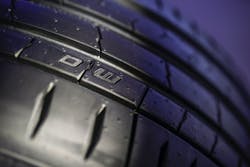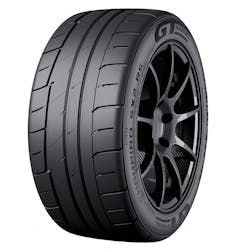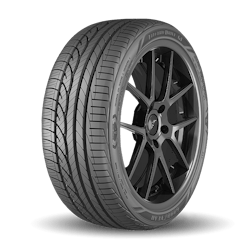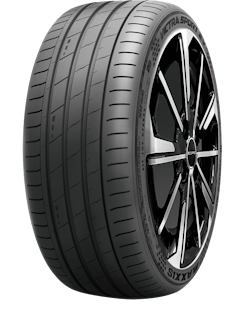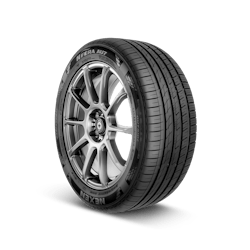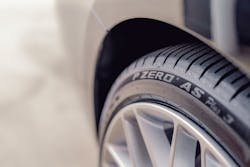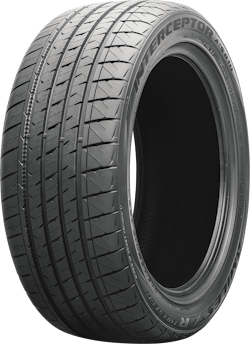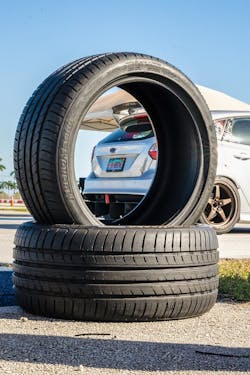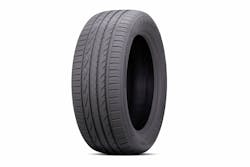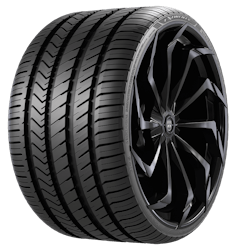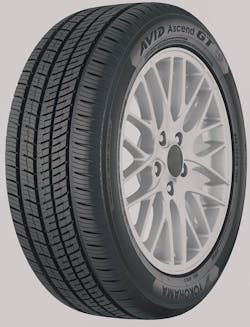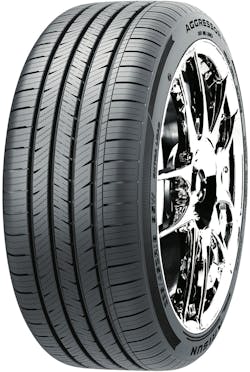As the automotive industry hurtles into a new era of sustainability and performance, tire manufacturers are at the forefront of innovation, striving to meet the demands of customers seeking high performance (HP) and ultra-high performance (UHP) tires.
As the market for these products rapidly evolves, tire manufacturers provide updates on the latest HP and UHP tire trends and technologies in this MTD exclusive.
MTD: What new trends in HP and UHP tires are you seeing right now?
Brandon Stotsenburg, vice president of automotive, American Kenda Rubber Industrial Co. Ltd.: Kenda sees several key trends in the North American market in the true performance segment. First, HP tires have been moving from H-rated to primarily V-rated for new vehicle applications. UHP further segments into summer and all-season, with UHP all-season growing increasingly more prevalent.
Summer UHP breaks down further to include max performance and competition tires that are often stamped DOT for street use, but not seen outside of weekend competition. There has been an increasing trend to see UHP tires in weekend competitions. Kenda has translated the street performance that we demonstrate with our Vezda brand through our DOT racing activities, competing on the same tires that we sell via our Kenda retailers and we identify as “Podium2Pavement.” We learn and improve the materials and construction using the racing activities that translate directly to the end consumer for UHP driving.
Another trend has been for many of the crossover and small SUV applications to have performance requiring UHP tires. As these are automotive platforms with suspension systems, the tire applications are increasingly reflecting the necessary performance. This is particularly apparent with EV vehicles that often require the high-speed ratings of UHP tires.
Steven Liu, vice president of product development, Hercules, American Tire Distributors Inc.(Hercules): We are seeing the trend towards small- to mid-size (and) even full-size CUV/SUV and electric vehicle (EV) applications for performance tires, thus pushing for higher rim diameters sizes on the OEM side, which ultimately will trickle down to replacement tire demand. Beyond the traditional classification method between HP/UHP (tires), with speed rating, rim diameters, load index and specific performance attributes such as dry/wet traction, nowadays there’s a bigger push for lower rolling resistance and this (has) resulted in a diverse assortment of performance-oriented products.
We believe this evolution provides a great opportunity for our customers to optimize margin and (place) a renewed focus on the performance segment. At the end of the day, we believe as the car parc has evolved, while there are many performance sub-segments, our goal is making sure every performance (HP or UHP) tire we develop is geared towards the driver, with vehicle dynamics in mind.
Karl Jin, divisional head of product and pricing for passenger car and light truck, Apollo Tyres Ltd. (Vredestein): We continue to see the broad proliferation of HP and UHP products across the industry, with a noticeable trend around expanded sizing as tire manufacturers cater to CUV and SUV drivers. In addition, there’s a market shift underway, as some all-season volume transitions to the all-weather category. UHP’s summer demand holds steady, with minimal adjustments.
From a manufacturer standpoint, addressing the market demand across all three UHP categories — all-season, all-weather and summer — calls for a diverse size range to address market preferences. For instance, despite being a smaller segment in terms of overall demand, UHP summer requires more than 100 different sizes to cover the need for staggered fitments. In line with our strategic vision, we have invested in the UHP summer lineup and are preparing to launch 100 SKUs for the new Vredestein Ultrac Pro — half in 2024 and the remainder in 2025, all of which carry a Y speed rating. In the UHP all-weather segment, we’re poised to launch 100 SKUs of the new Quatrac Pro Plus, with availability starting in January 2024.
Michael Mathis, president, Atturo Tire Corp.: Overall, the HP/UHP market is growing. We see broad trends in the continual increase in rim size, increase in staggered fitments (for) both OE and aftermarket and the development of all weather, 3-Peak Mountain Snowflake (3PMS)-certified high performance tires. Atturo strives to educate dealers on how to qualify customers who are potential HP/UHP customers. There is an increasing number of vehicles that can achieve increased performance by a simple tire change.
Ian McKenney, senior product manager, Bridgestone Americas Inc.: The automotive industry is witnessing a persistent trend toward the adoption of larger rim diameters for wheels and tires by both consumers and OEMs. The shift is particularly notable in the performance tire segment, where there’s a growing emphasis on accommodating higher rim sizes, especially on CUV applications. As the performance tire market continues to expand and adapt to these trends, we’ve seen smaller rim diameter tire sizes decrease with new product offerings. While we continue to develop products within the HP and UHP segments, it’s crucial to be attentive to these industry trends. This involves maintaining a diverse range of traditional 17-inch and 18-inch performance (tires) and sizes, while simultaneously extending coverage to meet the rising demand for 19-, 20- and 21-inch sizes requested by OEMs.
In terms of volume, performance tires see their highest demand from sports cars and sports sedans dominating today’s roads. The 17-inch sizes — catering to popular imports such as the Toyota Camry, Nissan Altima and Honda Accord — are particularly favored. Additionally, there is significant traction in domestic muscle car fitments, exemplified by the 18-inch size for the Ford Mustang. Meanwhile, the 17-inch and 18-inch sizes for German offerings like the BMW 2 and 3 series also have considerable popularity.
Additionally, the HP and UHP segments have been affected by an increase in speed ratings. Previously, a performance all-season tire line would be competitive with a speed rating of H (max 130 mph) or V (max 149 mph). As the modern car parc has adapted to vehicle trends, all-season performance tires often need a speed rating of W (max 168 mph) or even Y (max 186 mph) to have appropriate coverage in this segment. When it’s time to replace their OE tires, consumers now must look for a comparable speed-rated tire, which means we’re elevating speed ratings on replacement tires to match the new OE standards.
Nate Dodds, product manager for performance tires, Continental Tire the Americas LLC: One of the most recent changes in the HP segment has been the introduction of all-weather products that are more geared towards wet and winter performance, while also offering competitive highway handling and tread life.
In UHP, specifically UHP all-season, we continue to add fitments for performance CUV/SUV vehicles. Consumers are looking for a tire that can do it all, in regard to balancing wet, dry, rolling resistance, wear and winter capability. Second, with the increasing trend towards electrification, mileage will continue in importance for customers purchasing a UHP all-season tire due to the increased torque and weight of those vehicles.
For UHP summer, the trend is to higher and higher levels of dry and wet traction. As well, consumers are looking for a tire that provides the ultimate in response and handling for their sports car or other type of performance vehicle. In all categories, OEMs continue to push for lower (rolling) resistance tires in order to improve the overall efficiency of the vehicle, whether it’s an EV or an internal combustion engine vehicle.
David Poling, vice president R&D and Technical Giti Tire R&D Center (North America) Giti Tire (USA) Ltd.: Let’s begin by roughly defining HP tires as those having an H- and V-speed rating and UHP as having W and Y. In the past, there was a clearer delineation between HP and UHP tires. The UHP category generally captured the larger rim sizes and lower aspect ratios. However, today we see more HP tires in the larger rim diameters and lower aspect ratios. This trend is driven by the OEMs, who consistently place larger tires on vehicles, but keep the speed rating at H and V in many cases, making the fitments HP. But we shouldn’t assume this means that they are summer tires, because in fact, most of the HP tires going on at OE are all-season (tires). This is why we have seen a drop in HP summer and a rise in HP all season.
A similar situation is happening for UHP tires as well, where OE fitments are split between all-season and summer, with all-season being the larger volume. This doesn’t mean that the answer for the UHP all-season is a traditional UHP all-season, as most of the fitments are touring all-season tires with a W speed rating. I think the solution will be extending traditional all-season lines into the UHP speed rating requirements.
Michelle Baggetta, director of category strategy and planning for high performance and winter tires, Goodyear Tire and Rubber Co.: With the growth of the high performance CUV and EV markets, there is significant demand from OE vehicle manufacturers for W-, Y- and Z-rated tires, which has simultaneously driven growth of HP and UHP tires across the replacement market.
As consumer adoption of EVs shows no signs of slowing, there is a new need to engineer HP tires that are equipped with adequate features to handle EVs’ unique attributes, including requirements for load, noise, torque, rolling resistance and range. With the continued growth of the EV market, there is an opportunity for continued HP tire innovation to keep pace with drivers' and vehicles’ needs.
The high-performance CUV market has grown substantially over the past five years, which created a new need for performance-specific tires. As consumers continue to show preference for the aesthetic and functionality of CUVs, we anticipate that there will be a growing need for HP tires that provide all-around road performance.
Moonki Cho, product manager, Hankook Tire America Corp.: In the past, HP and UHP tires were normally reserved for sports cars and high-end performance trim levels. Today, especially within the HP category, we’re seeing a much broader application at the OE level across more general trim levels, in addition to rising consumer interest in ways to enjoy their vehicle's dynamic driving experience across more seasons than before. This has been the spark behind our recently launched Ventus S1 AS tire developed for performance-loving drivers who want to enjoy their car’s dynamic driving features year-round and across all seasons. For both the HP and UHP segments, performance will continue to improve for greater daily applications, whereas the latter may trend toward more specific use cases around racing and track performance.
John Wu, product strategy director, Maxxis International-USA: From a product point of view, the market for HP tires has dwindled as demand for UHP products continues to increase, and we expect UHP products to dominate the market. The extreme-performance summer segment has become quite competitive as more brands attempt to make a name for themselves in the UHP world. This type of UHP tire delivers track-focused performance, such as sharper response, higher cornering speeds, shorter braking distance and quicker dry lap times, while offering an acceptable level of on-road refinement. From an overall industry point of view, we’re seeing larger wheel diameter fitments continue as OE automakers bake in more profitability on sporty trim levels. We don’t see this trend slowing with EVs and hybrids, either.
Jay Lee, product marketing, Nexen Tire America Inc.: The UHP tire market is experiencing a notable shift driven by the diverse needs of consumers. Two distinct groups have emerged: performance enthusiasts seeking track-worthy UHP tires and consumers with factory-equipped UHP tires for their CUVs and SUVs. The latter group prioritizes comfort, fuel efficiency and a quiet ride over high-speed performance. The increasing prevalence of larger wheel packages on CUVs and SUVs is driving the demand for UHP tires with all-season characteristics. The forecasted fastest-growing segment in the UHP market is for tires that balance performance with features like quietness and comfort, meeting the preferences of consumers who do not prioritize track-level performance, but seek a versatile and enjoyable driving experience. Next-generation UHP tires are expected to incorporate more all-season characteristics to cater to this evolving market demand.
Ian Coke, chief technical officer, Pirelli Tire North America Inc.: The focus on sustainability is growing a lot. And while this has already been a point of emphasis for manufacturers recently, the continued growth of the SUV and CUV market for consumers remains a major influence on the production priorities of manufacturers. With this increased demand on the side of auto manufacturers, the onus is on tiremakers to pump out significantly more HP and UHP tires that lend better handling and decrease rolling resistance in order to benefit fuel efficiency.
Ken Coltrane, vice president of marketing and product development, Prinx Chengshan Tire North America, Inc: We are beginning to see more EV-capable designations.
Mike Park, assistant director of marketing, Tireco Inc.: Tire technology is advancing with a strong emphasis on performance improvement through innovative materials and construction techniques. Sustainability is a key focus, driving the development of eco-friendly tire options within the HP/UHP category. There’s also a growing interest in the potential for smart tires that can provide real-time data on tire pressure and tread depth.
Joaquin Gonzalez Jr., president, Tire Group International LLC: I wouldn’t necessarily call them new trends, rather trends which are gaining popularity:
All-season performance: Having a tire that offers great performance in various weather conditions and provides a balance of grip, handling, and comfort, making them suitable for year-round use.
More and more HP and UHP tires are now equipped with noise-canceling technologies. Consumers are becoming much more educated on their tire purchases and requesting features such as this, making it important for manufacturers to provide solutions.
Enhanced wet traction: Utilizing innovative tread patterns and compounds to provide better grip and handling on wet roads.
As sustainability becomes increasingly important, many tire manufacturers are introducing eco-friendly HP and UHP tire options. These tires are designed to have lower rolling resistance, which can result in improved fuel efficiency and reduced carbon emissions.
Chris Tolbert, director of sales, Trimax Tire: With continued market demand for high performance vehicles, we see optimistic growth towards luxury CUV, EV, hybrid and SUV, plus sports vehicles. With advanced technology and innovative tread patterns, HP and UHP tires are specifically designed to enhance the driving experience. The Haida HD937 all-season UHP is designed for many of these applications. Currently it is available in 42 sizes, from 16- to 30-inches. In the first quarter of 2024, we will introduce four sizes (in) 23 inches. Later in 2024, we will continue to expand 18 sizes in 17-, 18-, 19-, 20-, 21- and 22-inches.
Phillip Kane, CEO, Turbo Wholesale Tires: The new trends we are noticing in the market are that certain sizes that were historically known to be UHP tires are seen more as HP tires today. If you look back five to 10 years ago, 17-, 18- and, especially, 19-inch tires were traditionally known to be UHP. In the present day, these tires are seen coming OEM on most new models. You see these tires today come more as touring tires with 60,000-plus mileage warranties. This is also the case for some 20-inch tires.
Ryan Parszik, manager, product planning, Yokohama Tire Corp.: Overall, tires continue to get better in terms of actual performance (i.e., handling characteristics, braking distance, ride, noise, etc.), but customer and consumer expectations have also increased. This is partly due to changing vehicle dynamics and the positioning of HP and UHP tires across a wider range of platforms. For example, a current model year Toyota Camry comes equipped with a 19-inch, V-rated tire. Historically, the tire industry would have considered that option as a pure performance tire. However, a Camry buyer and owner likely isn’t looking for a pure performance tire in the traditional sense of the word.
Now, that tire must do all the things a V-rated tire needs to do in terms of handling and braking, but also deliver a comfortable ride and provide extended longevity. So we see big performance improvements and categories like “grand touring,” where Yokohama’s Avid Ascend GT is a perfect option in the Camry example. We also see more traditional performance tires like Yokohama’s Advan Apex with an extreme focus on performance handling now coming with mileage warranties.
Zhongce Rubber Group Co. Ltd. (ZC Rubber): One of the major trends that is currently being seen in the HP and UHP tire segment is the rise of electric vehicles. As more and more people switch to EVs, there is a growing demand for tires that are specifically designed to meet the unique requirements of electric vehicles.
MTD: What will be the next innovation for HP/UHP tires?
Stotsenburg (Kenda): Kenda sees the primary need for UHP segment innovation for a true four-season tire that offers all of the dry, wet and winter benefits that are available in grand touring tires now offered by leading brands. The current tradeoffs in North America are providing all of the benefits with a true UHP W- or Y-rated tire, including 3PMSF certification, while not sacrificing expected wear rates that the North American consumer desires for 40,000-mile to 50,000-mile warranties. The material solutions combined with the mechanical tread designs are now offered in touring tires like the Vezda Tou Touring 4S, which is H or V-rated, offers excellent wet and winter performance in addition to a 60,000-mile warranty. The next innovation will be to increase the performance of a true UHP tire, which offers a strong dry and wet grip for UHP applications with the addition of 3PMSF certification and good wear.
Liu (Hercules): Based on Hercules Tires’ current product screen and forward strategy, we saw the technological advancement in both auto and tire manufacturers and the shift to CUV/SUV vehicles. For us, with the traditional HP category, we’re combining into standard/grand touring, where the focus is mileage, comfort (and) ride quality, with the added dose of performance elements.
Jin (Vredestein): The HP/UHP segment is constantly innovating, as incremental performance benefits are very important to that consumer. A new frontier in HP/UHP tire innovation is achieving equal mileage warranties for both CUV and SUV sizes — finding an optimal balance in treadwear. Our latest UHP summer tire, the Vredestein Ultrac Pro, looks to address exactly this through its finely tuned blend of comfort and control.
This is in addition to the ongoing push for innovations tied to sustainability, which spans all segments, including HP/UHP. This covers a range of focus areas, from sourcing more eco-friendly raw materials to compound development to final manufacturing. The objective is to deliver tires that perform at the levels customers demand while integrating materials and processes that lighten the environmental footprint. This is a core focus for Vredestein globally.
Mathis (Atturo): We see continual evolution in reducing the tradeoffs of rolling resistance versus grip. Another innovation will be the advancement of connected tire technology integrated with the tire, vehicle and back to the retail dealer.
McKinney (Bridgestone): The performance tire market is incredibly competitive, with tire manufacturers vying for incremental performance improvements. Present-day products exhibit enhanced wet and dry handling performance, as anticipated. However, there has been remarkable progress in winter traction and wear life within the past few years. While a revolutionary shift in the performance segment is not expected, the focus is likely to remain on improving wet and dry handling and enhancing winter traction.
With the increasing prevalence of electric vehicles, there is a growing need for an additional level of scrutiny on wear life and noise performance to ensure consumer satisfaction. Given the hyper-competitive nature of the industry, tiremakers are actively seeking distinguishing factors for their products. Therefore, we can anticipate ongoing innovations aimed at reducing rolling resistance, preserving range and prioritizing top-tier performance, with material sustainability in mind.
Dodds (Continental): The innovation areas will continue to be on reducing rolling resistance for the OEMs and increasing tire mileage for the end consumer.
Poling (Giti): Innovation in these markets will be driven largely by OE requirements. As many (tires) find their way onto EVs, there will be a push for noise reduction. In the same way, rolling resistance reduction will continue to play a key role across EV, hybrid and ICE vehicles. Some regulations currently coming out of the European Union will drive innovation around treadwear and tire abrasion.
Baggetta (Goodyear): The rise of vehicle connectivity has unlocked new capabilities for cars to process data and deliver information to drivers. The tire is the only part of the vehicle that touches the road. This contact point has the potential to provide important data to the vehicle.
Cho (Hankook): As the performance of regular vehicles improves, HP tires will start to take on more and more touring tire qualities concerning seasonal flexibility, along with mileage, comfort and traction in a premium performance product. This innovative success will only further as R&D teams test new rubber compounds, tread patterns and structural architectures to further diversify the growing segment. A similar methodology will be applied within the UHP segment and upgraded for specific customers concerning heightened performance for competitive driving. This kind of pursuit in extending and evolving the application of a category also applies to new platforms as we’ve begun to see and support within the electric vehicle segment.
Wu (Maxxis): The next tire innovations will involve designs that adapt to the heavier, higher-torque and higher-horsepower hybrid or electric sports cars and sports sedans, delivering ultimate dry and wet traction while also addressing considerations such as noise, vibration and harshness and even range.
Lee (Nexen): The tire market is witnessing a significant trend with the introduction of heavy load (HL) tires into the HP and UHP segments. Traditionally, standard load and extra load tires were prevalent, but the emergence of electric vehicles has led to the need for tires capable of handling the increased weight of modern EV batteries. The HL classification is designed to address this demand, providing tires with a higher load rating to accommodate the heavier batteries in EVs. This development underscores the dynamic nature of the automotive industry, where evolving vehicle technologies, especially the widespread adoption of electric vehicles, are influencing tire demands. Even within the UHP category, which was traditionally associated with sports cars, there is a growing need for more capable tires that can meet the diverse requirements of a wide range of vehicles, including the expanding market of electric vehicles.
Coke (Pirelli): With the significant growth in the electric vehicle market, and particularly in high performance EVs from manufacturers like BMW, Rivian and Porsche, expect to see much more research and development on materials and tread patterns that will be able to provide a premium driving experience. EVs carry much more weight than traditional vehicles with internal combustion engines, so electric HP and UHP tires need to be designed to better handle that weight and enable drivers to have the precise control and zip they’ve come to expect without sacrificing battery range or tread life.
Coltrane (Prinx): I would not be surprised to see the new HL prefix for tire sizes begin to show up more frequently in this segment.
Park (Tireco): There will be continuous advances in materials and construction that will contribute to improved fuel efficiency and overall vehicle performance.
Gonzalez (TGI): It would be very tough to single out one specific innovation. There is no doubt we will continue to see improvements across the board on performance, noise reduction, grip, comfort and durability of tires. Maybe we will find a way of utilizing smart technology to integrate or connect tires to our vehicles in more ways than just with lug nuts. As of right now, the only feedback we get on tires in our vehicles is through the tire pressure monitoring systems. Maybe there (will be) a day where we will be able to see how all the different characteristics of our tires are performing in real time.
Kevin Arima, senior product manager, Toyo Tire U.S.A. Corp.: With anticipated growth in the number of sports BEVs and sporty BEVs, future generations of tires will better address these performance needs of instant torque while improving range and tread life and maintaining a quiet ride. This will be accomplished by adopting innovative compounding, new materials and incorporating new development methods, all the while accounting for sustainable practices to develop tire solutions to meet end-user needs.
Tolbert (Trimax): Tire manufacturers continue to focus on improving tire performance characteristics for dry and wet traction, cornering stability, braking efficiency, rolling resistance, fuel efficiency, tire noise and weight requirements.
Kane (Turbo): I think the next big innovation for HP/UHP tires is going to be in the EV tires segment of the industry. As EV tires become more and more common in the industry, companies and brands will look to innovate and continue to expand product sizing. There is also a huge innovation in the mid-tier SUV/CUV market because the demand for those types of vehicles has exploded in the last couple of years.
Parszik (Yokohama): Familiar benefits in the form of all-season traction, wear resistance and load carrying capacities will all drive innovation in the performance segment. The increasingly common adoption of the 3PMS symbol in a multitude of segments will make its way into all-season offerings within the category. Additionally, changes in vehicles, led by EVs, have increased weight and put tremendous pressure on tire life. The new Yokohama Advan Sport EV A/S was designed specifically to take on some of these challenges.
ZC Rubber: Looking towards the future, the next big innovation for HP/UHP tires is expected to be the development of specialized EV tires. These tires will be designed to meet the specific requirements of EVs, such as higher load-carrying capacity, lower rolling resistance, improved tread wear and excellent braking performance. Additionally, there is also a rising demand for all-season EV tires that can perform well in various weather conditions.
MTD: With the rise of electric vehicles and hybrid cars, how are HP/UHP tires adapting to meet the unique requirements of these vehicles? Do they require specific technologies or materials?
Stotsenburg (Kenda): Vehicle application specifics determine the answer to these questions, with some specific consumer preferences or needs further defining the answer. Kenda’s current Vezda lineup will fit EV applications depending on the speed/load ratings, but optimized performance for wear will require additional construction, mechanical design and material modifications based on the following elements. Specifically, the following application elements are the drivers in this decision (as) within the North American (tire) market, right now EV applications are primarily W- or Y-rated and UHP by definition:
- Load/heavier weight (is) based on the weight of the vehicle, primarily affected by the battery. This may require a tire with a higher rating, including XL or HL for non-light truck designations. This also affects the expected wear of the tire;
- The higher performance and torque for most EVs have required V- or W-rated tires that affect the wear of tires on EV applications. To improve the grip needed from stronger initial acceleration and higher output, this may require both mechanical and compounding changes for the tires;
- As EV vehicles are inherently quieter than ICE vehicles, tire noise from non-EV tires will be more noticeable. There are noise reduction technologies available to improve this issue, but it does require potentially more costly changes to the tire. This issue is important for most consumers, particularly in initial replacement cycles;
- EV vehicle range is affected by the rolling resistance of the tire. There are trade-offs to offering enhanced rolling resistance which may affect wear;
- Currently, many EV applications are provided with tires that have limitations related to four season performance. Depending on the application, summer performance has been prioritized. Many consumers require four-season capability.
As always, the load and speed rating requirement as defined by the vehicle applications cannot be compromised. The other elements likely affect performance and benefits that consumers need to understand relative to trade-offs. The most obvious one that everyone is seeing relates to wear, as most EV tires currently have shorter expected wear primarily due to the vehicle design and use, but also related to the design decisions from the tire manufacturer or OEM.
As the EV vehicle market is currently evolving both globally and in North America, there are many potential options to determine EV tire decisions. Although Kenda is not currently offering EV-specifc options in North America, we are accelerating the analysis in the rapidly evolving market.
Liu (Hercules): With the ongoing changes and improvement in the EV/hybrid vehicle world related to both auto and tire manufacturers, we believe the market will sort it out over the course of the next few years. Needless to say, as Hercules Tires remains one of the premier value brands in the marketplace, our goal is to continue to focus on maintaining specific performance criteria that satisfy our customers, recognizing the baseline is rising and we have to stay proactive. Secondly, we’re going to be hyper-focused on the development of EV and hybrid vehicles as the market matures, identifying what are the table stakes and what are the trade-offs of utilizing UHP tire design as the platform. The reality is when it comes to a HP/UHP tire, W-rated is not so much a differentiator anymore. Last but not least, there is angst from all sides attempting to offer a solution addressing the balance between vehicle dynamics, battery range, treadwear/mileage and cost. Ultimately, performance needs will vary.
Jin (Vredestein): It’s a balancing act. HP and UHP customers, especially in the replacement market, have defined expectations for how their tires improve overall performance and handling. In many respects, HP and UHP tires are a natural fit for EVs, given that their baseline levels of performance are so elevated compared to many of their mass-market combustion-engine counterparts. For this customer, it’s a matter of ensuring that the products meet the additional load requirements that EVs may place on the tire. We also understand that some EV customers may place a high value on efficiency and longevity in addition to high performance. As a result, several new EV-specific performance tires have come to market from a range of manufacturers. Because we develop performance tires for so many different vehicle types and use cases, we are well-positioned to serve EV drivers with our existing lineup. Ongoing collaboration with our retail partners lets us understand what drivers prioritize, so that we can address those requirements in our product-development processes. This, naturally, includes EV customers.
Mathis (Atturo): Electric and hybrid vehicles are excellent candidates for HP/UHP tires. Most EVs are equipped with OE tires focused on low rolling resistance at the expense of performance-oriented grip. The upgrade to an HP/UHP tire will unleash the performance potential of these vehicles for the driver seeking that feature. As long as the tire meets the original load and speed index, aftermarket HP/UHP tires are suitable for use on EV/hybrid vehicles.
McKinney (Bridgestone): The push for electrification continues to grow the popularity of electric and hybrid vehicles and it’s important for tire manufacturers to factor in their unique performance benefits. EVs offer tremendous performance benefits like low noise and instantaneous torque, but these factors, along with increased vehicle mass, have real implications for tire design. According to our research, EVs go through a set of tires roughly 30% to 40% more quickly than their comparable internal combustion engine counterparts. This is an element that Bridgestone addressed in its latest UHP offering, the Bridgestone Potenza Sport AS. (The Bridgestone Potenza Sport AS, designed to support popular sports cars, sedans and performance crossovers, including applicable electric and hybrid performance vehicles, is Bridgestone’s first ultra-high performance all-season tire to feature Bridgestone ENLITEN technology.) As consumption of electric vehicles and hybrid cars increases, the HP and UHP performance tire segments will continue to evolve and meet the unique requirements of these vehicles without trading off expected performance.
Dodds (Continental): In both segments, we continue to bring out new fitments that meet the increasing trend of electric vehicles — in this case, bringing out new sizes that offer the correct load index and speed symbol to match the vehicle’s OEM tire. Additionally, as new vehicles enter the market with high load fitments as OE, we will begin looking at bringing those sizes as high load to the replacement market.
Poling (Giti): The increase in EVs will require adaptations, of course. However, manufacturers are approaching the technical and line offering requirements in many ways. The technical challenges are not as severe as they seem with the modern EV driveline control systems that limit issues coming from the high torque available. The key, as tire manufacturers, is to address the needs of the market, while keeping the ever-growing complexity to a minimum for us and our dealers.
Baggetta (Goodyear): The design of HP and UHP tires are adapted to be compatible with the technical requirements for electric vehicles and hybrid cars. The added weight and torque associated with EVs can impact several factors when it comes to tire performance — most importantly load capacity, tread wear and vehicle range. The Goodyear ElectricDrive GT was designed with these elements in mind.
Beyond functional adaptations, HP and UHP tires should cater to EV drivers’ expectations for a quiet ride. EV drivers view their vehicles as a source of enjoyment — not just a means of transportation. Rather than solely focusing on efficient tires for a longer range, consumers prefer balanced all-season tires that meet more of their driving needs. Given this shift in perception, Goodyear focuses on a consumer-centric approach to serve drivers’ evolving lifestyles, while meeting EVs’ functional requirements.
Cho (Hankook): Due to the inherent differences an EV platform poses in comparison to a conventional ICE vehicle, there are several factors regarding heavier weight, power delivery profile and road-going noise that, in several ways, require a rethink of a tire’s application, especially within performance categories. Tread compounds, for example, require new combinations and innovations behind their highly functionalized and flexible polymer to be combined with highly dispersible silica, resin, natural oils and other materials to withstand the elevated power of these performance EV applications. Once more, a standard or entry-level EV carries performance figures, especially regarding acceleration, that would be on par with high-performance ICE chassis. With that in mind, special consideration must be applied when developing a high-performance version of an EV tire that satisfies the needs of safety, elevated performance, battery range and balance across multiple seasons.
Wu (Maxxis): The next tire innovations will involve designs that adapt to the heavier, higher-torque and higher-horsepower hybrid or electric sports cars and sports sedans, delivering ultimate dry and wet traction while also addressing considerations such as NVH (noise, vibration and harshness) and even range.
Lee (Nexen): One of the key considerations for tires in electric and hybrid vehicles is minimizing rolling resistance. Lower rolling resistance contributes to increased energy efficiency, which is crucial for maximizing the driving range of electric vehicles. Tire manufacturers are developing tires with specialized tread compounds and designs to achieve this goal.
Electric vehicles often have a different weight distribution compared to traditional internal combustion engine vehicles due to the placement of heavy battery packs. Tire manufacturers may design tires to accommodate the specific weight distribution of electric vehicles and provide optimal load-bearing capacity.
Electric vehicles are known for their quiet operation. Tires designed for EVs may incorporate technologies to reduce road noise, providing a quieter and more comfortable driving experience. Electric vehicles (also) generate less heat compared to traditional vehicles with internal combustion engines. Tires designed for EVs may need to manage heat differently to ensure optimal performance and longevity.
Electric vehicles often have instant torque, which can impact tire wear. Tire manufacturers may focus on developing durable compounds to withstand the unique wear patterns associated with electric vehicle driving. HP and UHP tires for electric and hybrid vehicles may also be designed with aerodynamics in mind to contribute to the overall efficiency of the vehicle.
The integration of smart tire technologies, such as tire pressure monitoring systems (TPMS) and sensors, is becoming more common. These technologies can provide real-time data to the driver and contribute to the overall safety and efficiency of the vehicle. It's important to note that tire manufacturers continuously innovate and adapt to the evolving automotive landscape. As electric and hybrid vehicles become more prevalent, the tire industry is likely to see further developments to address the specific needs and challenges associated with these types of vehicles.
Coke (Pirelli): As mentioned above, electric HP and UHP tires require a unique construction that offsets the challenges that come with increased weight and limited range on electric vehicles, particularly high-performance models.
A few of the main adaptations in the ways these tires are made include much lower rolling resistance, in order to reduce the energy consumption needed to keep these heavy vehicles moving.
HP and UHP electric tires (also) require the perfect combination of materials, tread pattern, design and structure deformation to best handle the vertical weight distribution of EVs so that control and safety is not compromised.
Unlike internal combustion engines, EVs transmit torque to the wheels instantly. For non-EV tires, this could be incredibly damaging to the treads. To keep this level of power alive and under control, the tires require a specific compound that provides significant and immediate grip.
And possibly one of the most stark differences between traditional HP and UHP vehicles and their electric counterparts is the lack of noise. This is a big selling point for many consumers, as it can enhance their comfort levels on the road. Many tiremakers, Pirelli included, look to minimize the impact that EV tires would have on noise levels by using optimized tread patterns and structural changes that keep ambient sound at a minimum.
Coltrane (Prinx): Prinx Chengshan has developed its own proprietary technology to reduce noise. Lower rolling resistance is also a big factor in these tires.
Park (Tireco): Manufacturers are developing tires with advanced tread compounds and construction that can provide low rolling resistance tires, which enhance energy efficiency and extend overall range. Because electric vehicles weigh more, tires are designed to meet higher load carrying capacity and there is also a focus on minimizing noise through tread patterns and materials to enhance the driving experience.
Gonzalez (TGI): The rise of electric vehicles and hybrid cars has indeed brought about new considerations for HP/UHP tires. These vehicles have unique requirements that tire manufacturers must adapt to. Low rolling resistance, increased load capacity, noise reduction and size proliferation are some of the key attributes we will see tiremakers pushing their next-gen product development into.
Tolbert (Trimax): With EVs, you have increased torque, vehicle weight and reduced vehicle noise. Tire manufacturers must focus on these characteristics to enhance driver experience. This is why many tire manufactures are introducing EV tires.
Kane (Turbo): A lot of (tiremakers) are coming out with technological innovations and creating a rubber compound that can hold up the weight of the car and allow the consumer to enjoy a quiet and comfortable ride with low resistance. The first-generation EV tires did not last nearly as long as the ones being manufactured in the present day, which shows that manufacturers are becoming more and more educated on how to build these tires.
Parszik (Yokohama): Electric vehicles have a lot more weight and torque than a traditional ICE vehicle. Consumers, however, have the same expectations and demands from their past experience, so this has created a new hurdle for the manufacturer. A tire applied to an EV today must fulfill new EV requirements, such as carrying a heavier load, performing with the additional torque and providing an extraordinarily quiet ride due to the absence of engine noise without compromising on traditional performance requirements. (The Yokohama Advan Sport EV A/S does just that by meeting the EV needs, while exceeding the consumer needs, especially as it relates to wear.) Further complicating the segment is the fact that some EVs are now requiring a new load range, HL, or high load as a result of the increased battery weight. The HL has a carrying capacity greater than a standard load or extra load tire. Yokohama offers HL tires for some OE applications.
ZC Rubber: As electric vehicles continue to grow in popularity, the HP/UHP tire industry is facing unique challenges in meeting the specific requirements of these vehicles. With their quick acceleration and heavy weight, EVs pose unique challenges for tire manufacturers. These vehicles require tires that can provide better tread wear and excellent braking performance and have low rolling resistance. And it is the task of tire manufacturers to find the perfect balance between these three factors in order to deliver the best performance. To address these demands, ZC Rubber is investing in research and development to create specialized tires for EVs. We launched the EV Pro series for the Chinese market and plan to introduce it globally soon. This series focuses on providing a balance of grip, fuel efficiency, comfort and silence for electric vehicles.
In conclusion, the HP/UHP tire industry is adapting to the rise of electric and hybrid vehicles by developing tires that meet their specific needs. With continuous research and development, we can expect to see more innovations in EV tires in the future.

